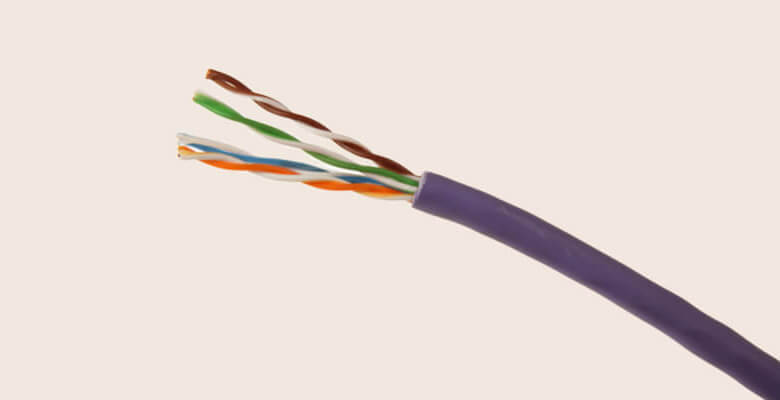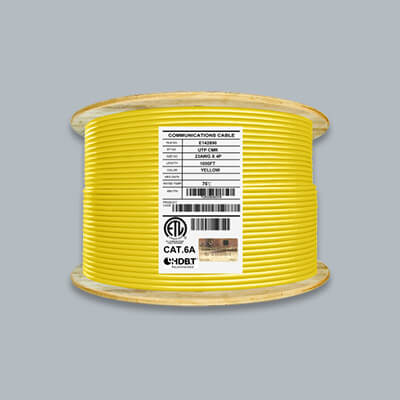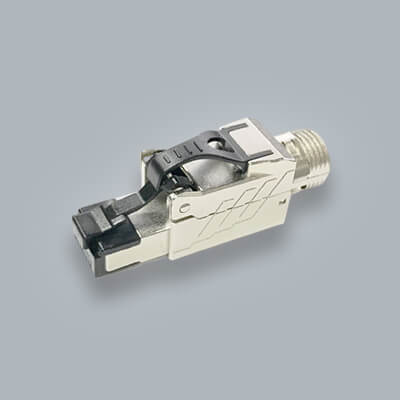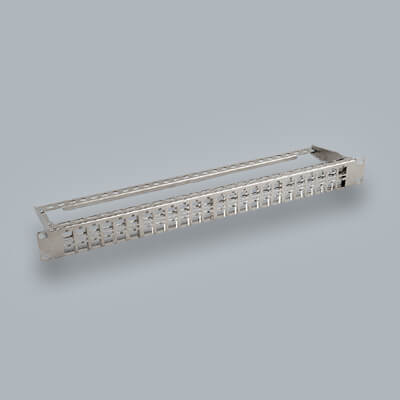Cat 5 Cable Speed: Explained

Let's take it back to one of the original cable categories. It wasn't too long ago where this category of cable was the newest around. Cat 5 is an advancement on Cat3 and Cat4 ethernet cables. The beginning of Cat5 cable began in 1995 and since then has been used in many homes and businesses. Believe it or not but many homes today still have this category of cable in their walls. So with Cat 5 cable as one of the longest standing networking cables around lets dive deeper into the category and take a look under its jacket. In this article we will cover all there is to know about Cat 5 and what is the Cat 5 cable speed?
Introducing Cat 5
As we mentioned in the introduction, product of Cat5 cable began in 1995 and would soon become the fastest ethernet cable around. Ethernet cables are used to connect your homes or businesses networking hardware. Cables such as Cat5 can be used to power your computer, modem, routers, gaming system, printers, faxes and just about anything with an ethernet port. With the early onset of technological advances starting with the invention of the internet and computing hardware came the need for advances in ways to send data. This is where Cat3, Cat4 and Cat5 came in to its place. Each of these categories advanced on the previous version of itself. Giving home and business users more networking capabilities.
What Is The Cat 5 Speed?
At its time Cat5 cable would become the first ethernet cable to be able to power 10/100 Mbps (Megabits per second). This type of performance is very fast considering when it started. This cable can be seen to truly kick off the advances in networking requirements from home users and businesses.
With 100Mbps you can actually run high speed internet in your home. If you are a single user you can power Netflix, YouTube, Online Gaming, HD Videos , Photos and your everyday internet use such as sending emails and reading this blog :)
Let's take a more technical look at the speed of Cat 5.
The Cat 5 speed is capable of 10/100 Mbps and frequencies up to 100MHz all at a length up to 100m (328 Feet). The Cat 5 performance is set by TIA/EIA which are engineering standards set by a group of individuals to give manufacturers, businesses and individuals clear expectations on cable performance. These guidelines are relative to the market and are formed with many people from the telecom industry to manufacturers.
More specifically, Cat5 cable speed is set by TIA/EIA 568-5-A. This standard was introduced in 1991.
With the advancement in technology ethernet standards have been able to maximize the life of Ethernet cable categories. Cat 5 cable was created for 100Mbps but with the creation of 1000Base-T (Gigabit Ethernet) you are able to run gigabit speeds using the four pairs of Cat 5 cable. It is recommended however to keep this channel length at short as possible for Cat 5 cable.
The Nitty and Gritty of Cat5
The standards and performance of Cat 5 cable cover many different attributes. With your Cat5 cable you can expect an assortment of applications
Types
Cat5 cable is offered in both stranded and solid conductor types. To touch on these types briefly a stranded cable is more flexible and great for custom length patch cords. The flexible conductors give it the ability to be installed in tight areas or bends. Solid cable is the cable of choice for when you are installing in the walls of your home or business. You'll often find solid conductor cable in riser and plenum rated cables. This is because these two types of cables are often installed over longer distances. Solid conductors give you better signal performance over longer distances.
Another type of Cat5 cable is shielded and unshielded. Unshielded has become the standard cable used everyday in home and businesses. The alternative to unshielded cable is shielded. Shielded ethernet cable is for areas with EMI/Signal interference that can interrupt your signal strength.
There also is the AWG size of these cable. For Cat5 cable used in backbone application you should look to use can that is 22AWG to 26AWG. More information here on American Wire Gauge (AWG).
The jacket ratings of Cat5 cables can come in many different types as well. the most common jacket types are:
- CM (General use such as patch cords for connecting device in the open)
- CMX (Outdoor rated cable for insulating outdoors in sun or rain)
- CMR (Riser rated cable for installing in the walls, between floors and risers)
- CMP (Plenum rated cable for installing in areas with air flow, drop ceilings, raised flooring with return air circulation)
Terminating Cat 5 Cable
Cat 5 cable can be terminated in a number of ways. The most common ways to terminate Cat 5 cable is using a keystone jack or 8P8C modular plug (RJ45). The way your cable is connected is also set by the standards of TIA/EIA-568-B. This standard determined the connector ecosystem around each category of cable.
When terminating Cat 5 cable using keystone jacks or 8P8C modular plugs you can use the T568A or T568B wiring scheme. Each of the wiring schemes arrange the wires in your cable a certain way. You simply follow the color guidelines for the wiring scheme you choose. Always remember to keep the wiring scheme the same on both ends.
Here's some additional information on the performance capabilities set by TIA/EIA for Cat5 connectors:
| Connector (100m) |
|
|
| NEXT @ 100 MHz | 40dB | |
| FEXT @ 100 MHz |
|
|
| Return Loss @ 20 MHz |
|
|
| Return Loss @ 100 MHz |
|
Uses for Cat 5 Cable
Cat5 cable has many different uses as we mentioned earlier but some of the most common applications of Cat5 cable is:
- Data
- Audio
- Video
- Telephony
It's actually possible to power a couple of these applications at the same time with one cable. Though not necessarily recommended but there are plans you can use to to power video or HDBaseT on one line.
Installing Cat 5 Cable
When installing Cat 5 cable it's important to keep it's specific construction in mind. Cat5 cables will usually have solid conductors in which you want to keep the cable as straight as possible. However that's just not possible a lot of the times. Especially when you are running cable in your home or businesses in the walls, floor to floor or in ventilation The recommended bend radius for Cat 5 cable is at most 4 X its outer diameter. Adhering to that much radius in your bends will help in keeping the integrity of the jacket, wires and insulation intact.
The Wires In Cat5 Cable
The individual wires in Cat5 cable have been created to improve on crosstalk compared to Cat3 and Cat4 cables. By giving the wires more a twist this helps in lowering signal noise from occurring on the wires. This aids in improving overall performance. When twisting the wires they are formed in to pairs which is why you will see the cables mentioned as 4 pair. It's typical to see wires with different twist ratios which is specified by each manufacturer. There currently is not a standard for twist ration on Cat5 cable.
Examples of Using Cat 5
Here are two examples of Cat5 cable speeds:
-
100 Mbps: This is a common speed for Cat5 cables and is sufficient for many everyday tasks, such as browsing the web, streaming video, and sending emails.
-
1000 Mbps (1 Gbps): This is a higher speed that is suitable for more demanding tasks, such as gaming, video conferencing, and transferring large files. A Cat5 cable with this speed can provide a fast and reliable internet connection for multiple devices at the same time.
The Future of Cat 5 Cable
What does the future for Cat5 cable hold? Well it has been around more almost 20 years now and it's still prevalent today. There are many homes that have this cable still installed in their home. You can say that it's performance still has a place among the many different categories. At 100Mbps this gives many people just enough power to run a lot of their devices. For the most basic of usage this is ok but with the advancement in technology and capabilities has come a need for more. With the introduction of 1000Base-T you can push your Cat 5 cable more when using all four pairs for gigabit. While we always recommend to go with the cable that is most reasonable for your situation it might be time to look at the newer generation of category cables.
Cat5e cable has been introduced to improve on Cat5 cable by giving you better performance against crosstalk and more headroom when running 1Gb up to 100 meters (328 Feet). This cable has become very popular among many because of its extra performance. This cable has slowly taken over Cat5 cable and really taken its place in the market. So if you're in the market for Cat5 cable we really recommend to look at Cat5e cables to start. If you think you need more and want additional future proofing then look to Cat6 and Cat6A cables
Conclusion
What was once of the most advanced ethernet cables in the market has slowly taken a back seat to the newer categories in the market today. Cat5e and Cat6 cables are two of the most popular cables for installing in homes today. Businesses have began running Cat6A and beyond for their networking needs. Choosing which cable is right for your needs is the place to start in your cable journey. With the advancement in technology we recommend to look to Cat5e, Cat6 or Cat6A and beyond.
Let's Recap:
- The Cat 5 cable speed is rated for 10/100 Mbps up to 100 meters (328 Feet)
- Performance set by TIA/EIA 568-5-A
- Cat 5 has four twisted pairs of copper wire
- Possible to get 1000Base-T over the four pairs
- Comes in unshielded or shielded
- Can be used for data, audio, video or telephony





